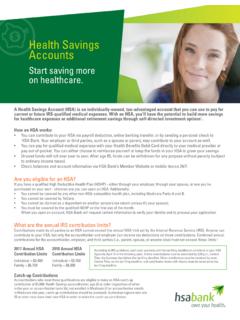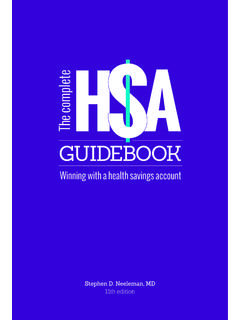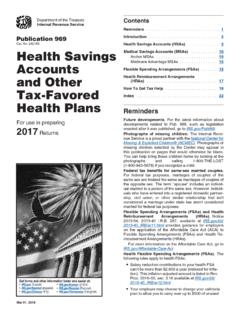Transcription of PENNSYLVANIA DEPARTMENT OF REVENUE - PA …
1 PENNSYLVANIA DEPARTMENT OF REVENUE PERSONAL INCOME TAX BULLETIN 2006-6 health savings ACCOUNTS ISSUED OCTOBER 23, 2006 Personal Income Tax Bulletin 2006-6 health savings Accounts 1. Overview. Act 2006-67 provides that substantially all the requirements of Section 220 of the Internal REVENUE Code (IRC) are applicable for PENNSYLVANIA Personal Income Tax Consequently, for tax years beginning after December 31, 2005, the taxation of health savings Accounts (HSAs) will follow the federal rules. Section 223 of the IRC outlines the taxability of HSAs on the federal level. The key attributes of an HSA include the following: Individuals with high deductible health insurance may make pre-tax contributions to an HSA.
2 Amounts paid or distributed out of an HSA that are used exclusively to pay the qualified medical expenses of the account beneficiary are not subject to tax. Amounts paid or distributed out of an HSA that are not used to pay qualified medical expenses are includible in income and are subject to tax. Excess contributions to an HSA are subject to tax. HSAs are exempt from taxation. This bulletin will explain the PENNSYLVANIA Personal Income Tax treatment of an HSA for taxable years beginning after December 31, 2005, using the following outline: 1 Act 2006-67 added the following provision to Article III of the Tax Reform Code: Except as provided in this Article and without regard to Sections 220(f)(4) and 223(f)(4) of the Internal REVENUE Code of 1986, the requirements of Sections 106(b) and (d), 220 and 223 of the Internal REVENUE Code of 1986, as amended to January 1, 2005, shall be applicable.
3 72 7303( ). PENNSYLVANIA DEPARTMENT of REVENUE Personal Income Tax Bulletin 2006-06 Issued October 23, 2006 Page Two 2. Definitions. 3. HSA contributions/deductions. 4. Reporting HSA contributions. 5. Reduction of contribution limit. 6. Rules for married people. 7. Distributions from an HSA. 8. Deemed distributions from an HSA. 9. Recordkeeping. 10. Balance in an HSA. 11. Death of HSA holder. 12. HSA reporting requirements. 2. Definitions. When used in this bulletin, the following words and phrases shall have the meanings given to them in this section: account beneficiary.
4 The term account beneficiary means the individual on whose behalf the HSA was established. Eligible individual. An individual qualifies as an eligible individual with respect to any month if the individual A. is covered under a high deductible health plan as of the 1st day of such month, B. is not entitled to Medicare benefits, C. has no other health care coverage except as described in other health coverage, and D. cannot be claimed as a dependent on another taxpayer s federal tax return. health savings account (HSA). A trust created or organized in the United States as a health savings account exclusively for the purpose of paying the qualified medical expenses of the account beneficiary provided the written governing instrument creating it contains the following requirements: A.
5 Contributions must be in cash. B. No contribution will be accepted to the extent such contribution when added to previous contributions made for PENNSYLVANIA DEPARTMENT of REVENUE Personal Income Tax Bulletin 2006-06 Issued October 23, 2006 Page Three the calendar year exceeds the annual deductible of the high deductible health plan plus the additional contribution allowed if the eligible individual has attained age 55 before the close of the tax year unless the contribution is a permitted rollover contribution. C. The trustee is a bank or another entity or person acceptable to the Secretary of the Treasury.
6 D. The assets of the trust will not be commingled with other property except in a common trust fund or common investment fund. E. The trust assets will not be invested in life insurance contracts. F. The individual interest in the balance in the account is nonforfeitable. High deductible health plan (HDHP). An HDHP has a higher annual deductible than a typical health plan. It also has a maximum limit on the sum of the annual deductible and out of pocket medical expenses that an individual must pay for covered expenses. Out-of- pocket expenses include co-payments and other expenses but do not include premiums.
7 An HDHP with family coverage may have deductibles for both the family as a whole (the umbrella deductible) and for individual family members (the embedded deductible). In 2006, federal law requires that the plan s deductible be at least: $1,050* - self-only coverage $2,100* - family coverage An HDHP can provide preventive care services with no deductible or a deductible below the minimum annual deductible. Preventive care includes routine pre-natal and well-child care, child and adult immunizations, annual physicals, mammograms, pap smears, etc. The maximum annual deductible and other out-of-pocket expenses required to be paid for covered benefits cannot exceed: * Each year this dollar amount changes as a result of the required annual cost-of living adjustment.
8 PENNSYLVANIA DEPARTMENT of REVENUE Personal Income Tax Bulletin 2006-06 Issued October 23, 2006 Page Four $5,450* - self-only coverage $10,500* - family coverage A network health plan shall not fail to be treated as an HDHP by reason of having an out-of-pocket limitation for services provided outside of a network of providers. A family plan will not qualify as an HDHP if either the umbrella deductible or the embedded deductible is less than the minimum annual deductible for family coverage ($2,100*). A family plan with no umbrella deductible will not qualify as an HDHP when the deductible for each family member multiplied by the number of family members exceeds the maximum annual deductible and other out- of-pocket expenses for family coverage ($10,500*).
9 A plan is not an HDHP if substantially all of the coverage it provides is for accidents, disability, dental care, vision care, or long-term care. Internal REVENUE Code. The Internal REVENUE Code of 1986 as amended to January 1, 2005. Other health coverage. An eligible individual s health care coverage is limited to an HDHP except for the following: A. Insurance which provides benefits only for 1. Liabilities incurred under workers compensation laws, tort liabilities, or liabilities related to ownership or use of property. 2. A specific disease or illness. 3. A fixed amount per day (or other period) of hospitalization.
10 B. Coverage (whether provided through insurance or otherwise) for the following items: 1. Accidents 2. Disability 3. Vision care 4. Dental care 5. Long-term care. C. A prescription drug plan if the plan does not provide benefits until the minimum annual deductible of the HDHP has been met. PENNSYLVANIA DEPARTMENT of REVENUE Personal Income Tax Bulletin 2006-06 Issued October 23, 2006 Page Five Qualified medical expenses. Expenses other than most insurance premiums that qualify for the federal medical and dental expenses deduction. Such expenses could be taken on a federal Schedule A by the HSA account beneficiary if they were not paid for by an HSA distribution.







